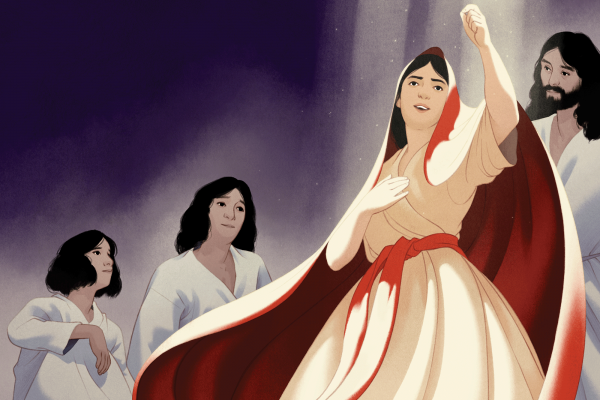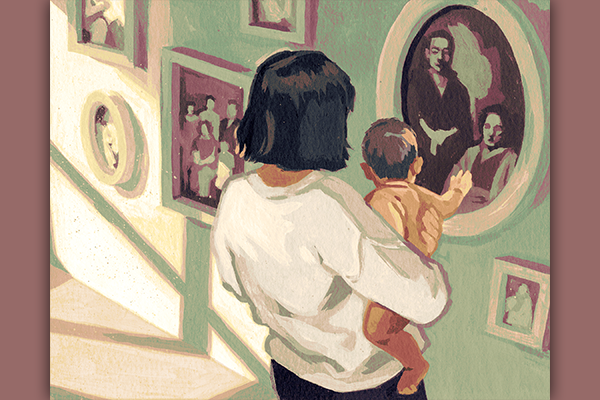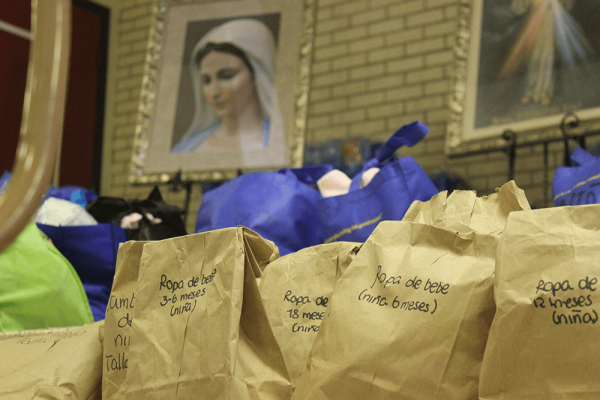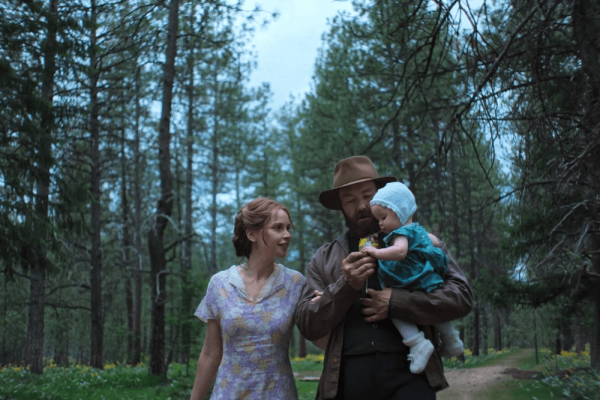MOST CHRISTIANS TODAY do not understand the life and teachings of Jesus as a broad vision of daring nonviolence. But scripture gives convincing evidence for this: The gospel of Luke presents Jesus as the God of peace who comes among us in total poverty into our impoverished world of war and empire, who brings with him God’s reign of peace and nonviolence, and who invites us to follow him on the path of love, compassion, and justice. With his birth, we hear the angels announce the coming of peace on earth.
Jesus, the greatest peacemaker in history, marked the path of peace toward Jerusalem, where he confronted imperial injustice and called us to learn the things that make for peace; he endured rejection, betrayal, torture, and execution in the holy spirit of nonviolence, and rose to offer his gift of peace and send us out all over again on his path of peace.
How did Jesus learn all this? Luke’s gospel offers an amazing answer. The writer presents Mary, Jesus’s holy Jewish mother, as his teacher of nonviolence.
Luke tells the story of Mary’s journey as three movements of creative nonviolence: the first, the Annunciation as a story of contemplative nonviolence, which leads to the second, the Visitation as the story of active nonviolence, which leads to the third, the Magnificat as the vision of prophetic nonviolence.
Movement 1: Contemplative nonviolence
THE ANNUNCIATION IS a scene of contemplative prayer in which Mary communes with the God of peace; in that silence and stillness, she encounters, and is ready for, God. Jesus learned this from his mother. We will see this in Jesus’s first public appearance when he sits by the Jordan River after his baptism and, in that contemplative peace, hears the God of peace call him “My beloved,” which sets him on his journey.
The first lesson of Lucan nonviolence is to sit in silence and solitude, in contemplative prayer, to open ourselves to God, to listen for God, and to be available if the God of peace chooses to speak. As Mary would have known, the first step in a peaceful life is to spend time in peace with the God of peace, to let God speak to us, to be ready if God sends us forth as peacemakers into the world of war.
Even though Mary is a person of prayer, like Zechariah, when the angel comes and greets her, her first reaction is fear. This is also instructive. When God enters our lives, we are afraid and disturbed. The first thing the angel says, once again, is “Do not be afraid.”
Lucan nonviolence also begins with a commandment, “Do not be afraid.” If we are going to proceed with Mary’s journey, read Luke’s gospel, and ultimately take up Jesus’ way of nonviolence, we must examine our fears right from the start, let them go, and embark on a new spirit of fearlessness, as Mary and Jesus did.
Mary speaks with the angel, asks questions, and moves from fear to confusion. The angel tells us, “The God of peace is doing this in you; a child will be born; he will be the savior of the world.”
What? “Savior of the world”? Isn’t that a title reserved for the Roman emperor? “You shall name him Jesus,” the angel continues. “He will be great and will be called Son of the Most High, and the Lord God will give him the throne of David his father, and he will rule over the house of Jacob forever, and of his kingdom there will be no end.”
Wait — his kingdom will have no end? We are so used to this, it’s hard to fathom the terrifying, unfathomable, political, revolutionary nature of this announcement. We are talking about an illegal vision, hope, and plan to welcome some kingdom other than the Roman Empire. This child and his kingdom will be greater than that empire. As we will soon learn, his kingdom is a reign of universal love, universal compassion, universal peace, and total nonviolence. Do we want that? Is Mary willing to risk political trouble with the current kingdoms of the world to welcome this never-ending reign of peace, love, and nonviolence?
Are we?
How is Mary able to accept the angel’s revolutionary message? This political announcement can only mean trouble for the child, and therefore for her, but she says yes without batting an eye. The answer lies in the way she speaks about herself: “the servant of God.” This is one of the most important teachings Mary will give to Jesus and the rest of us. The journey of peace and nonviolence comes down to and begins with our identity.
Mary knows that, first and foremost, she is the servant of the God of peace, so if the God of peace wants her to do something, the answer is yes, no matter what. She knows who she is.
Mary’s yes raises deep questions for us. Who are we? How do we see ourselves? The culture of war is always telling us who we are. Mary, by contrast, is a peacemaker. Luke is teaching us that if we want to be peacemakers like Mary, we too must identify ourselves first and foremost as servants of the God of peace. This is the best way to understand ourselves and life, and a holy spiritual practice.
According to Luke, Jesus clearly learns this lesson from his mother. During his 40 days of fasting in the wilderness, his greatest temptation was to renounce this fundamental identity. The tempter kept challenging him, “If you are the Son of God, prove it.” Jesus doesn’t need to prove it, and he doesn’t doubt it or reject his true identity. Notice, too, that in the Garden of Gethsemane, Jesus repeats the prayer he learned from his mother: “Let it be done to me according to your will.”
Movement 2: Active nonviolence
MARY'S EXPERIENCE OF contemplative peace and nonviolence leads to a second movement, to active peace and nonviolence. These public actions would become bedrock teachings of Luke’s Jesus. We’re told that Mary immediately set off in haste to the hill country to visit Elizabeth. This second movement is the story of two women sharing their experiences of God, serving one another, and in this way, living gospel nonviolence and welcoming God’s reign of peace: “When Elizabeth heard Mary’s greeting, the infant leaped in her womb, and Elizabeth, filled with the Holy Spirit, cried out in a loud voice and said, ‘Blessed are you among women and blessed is the fruit of your womb.’”
Here Luke teaches that the contemplative prayer and heartfelt surrender to God in the life of the nonviolent Mary leads her to get up, go out, and reach out in love to her neighbor in need. It will do the same with us. As we focus on God and doing God’s will, our encounter with God in our contemplative prayer stirs us to act on behalf of those in need, starting with those around us, like the elderly, needy Elizabeth.
Notice, too, their conversation. The first thing Mary would say when she reaches Elizabeth is “Shalom!” meaning, “Peace be with you.”
Jesus will later make this greeting the basis for the mission on which he sends his 72 disciples. Whatever house you enter, he will teach them, say, “Peace be with you.” When he rises from the dead, this will be his repeated greeting to the stunned disciples. Luke teaches here that active nonviolence and love for those in need uses the language of nonviolence.
When Elizabeth hears Mary’s greeting of peace, she rejoices, and even the child in her womb jumps for joy. The words of peace lead to joy, consolation, and, ultimately, blessing. If we speak words that hurt, insult, belittle, and humiliate, if we speak words of violence and war, we will not console anyone or give anyone joy. This is obvious but it needs to be underlined. We learn from the nonviolent Mary to speak the words of peace with one another and share our experience of the God of peace with one another.
From Luke’s Visitation story, we learn to become activists of God’s reign. Contemplative nonviolence pushes us to action — not vertical action, so that we focus solely on God and me alone — but horizontal action, to serve those in need around us, to offer concrete love in action.
Movement 3: Prophetic nonviolence
THE THIRD MOVEMENT of Mary’s progression is prophetic nonviolence. Her acceptance of God’s will and her reaching out to Elizabeth fill her with joy and consolation, which leads her to make a bold prophetic statement that is both a political denunciation of the empire and its culture of greed, war, and injustice and a proclamation about the God of peace and all that God is doing and will do for justice and peace throughout human history.
Remember: Mary is poor and pregnant and about to be a homeless refugee. Yet God has chosen her, and Luke portrays her here as a prophet of peace, directly in the tradition of Isaiah and Jeremiah. The spiritual journey of peace leads us to speak out publicly against systemic injustice and for the coming of God’s reign of justice and peace. Like Mary and Jesus, we too will have to become prophetic peacemakers who proclaim a new Magnificat to the world of injustice and war.
“My soul proclaims the greatness of God; my spirit rejoices in God my savior.” These are words of great consolation, focused on God, God’s greatness, and God’s saving action. It is also a public proclamation. Here Luke demonstrates how Mary taught Jesus, who will in turn teach his disciples and the rest of us to speak out publicly about God’s greatness and saving action.
Through this proclamation, Luke invites us to announce that, contrary to what the culture of war and greed says, God is a God of mercy and peace, and that God’s peace, mercy, and nonviolence are permanent, upon everyone throughout history.
I translate that also to mean that God is at work from generation to generation through movements of nonviolence. Even though we won’t read it in the daily papers, we can take heart that, as people encounter God and follow the nonviolent Jesus, as they join God’s peace movement and help disarm the world in preparation for the coming of peace on earth, they are doing God’s work, and God is working through them.
Mary then lists all the revolutionary actions God has done and is doing. She speaks radical, political words about social and economic justice for the poor and marginalized. Luke’s Mary announces to Elizabeth and the rest of us that the living God of justice and peace is leading a global, nonviolent revolution on behalf of the poor and oppressed: God has shown the strength of his arm; God has scattered the arrogant of mind and heart. God has thrown down the rulers from their thrones; God has lifted up the lowly. God has filled the hungry with good things; God has sent the rich away empty. God has remembered God’s mercy, according to God’s promise to our ancestors, to Abraham and Sarah and their descendants forever.
Mary declares that all these events have already happened and are happening.
These words reveal the true nature of Mary of Nazareth. She is a brilliant, holy prophet, and we are left to ponder who this child of hers will become. With her for a mother, we are not surprised at the wisdom, radical vision, and bold public prophetic words and deeds of Jesus. He could teach his followers these things because he learned them firsthand from one of the greatest prophets in history.
As we learn to proclaim our own magnificats throughout our lives, we boldly denounce injustice, war, greed, and violence of every kind; but, like Mary, we also boldly announce the coming of a new age of justice, equality, liberation, and peace. Moreover, we explain that this is the work of God, that this is what holiness looks like, that God has remembered mercy and nonviolence, and we should too.
This article was adapted from John Dear’s newest book The Gospel of Peace: A Commentary on Matthew, Mark, and Luke from the Perspective of Nonviolence (Orbis Books).

Got something to say about what you're reading? We value your feedback!






